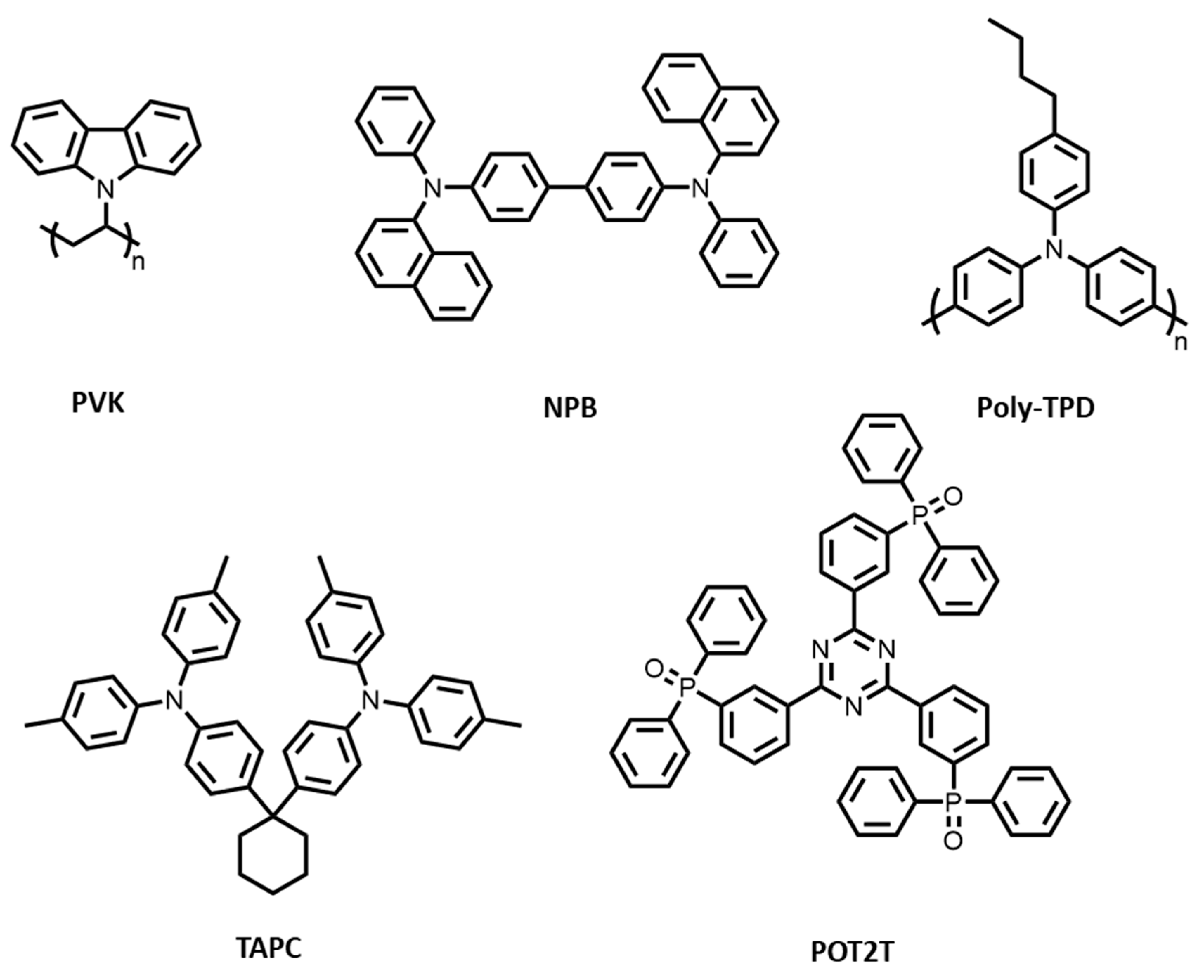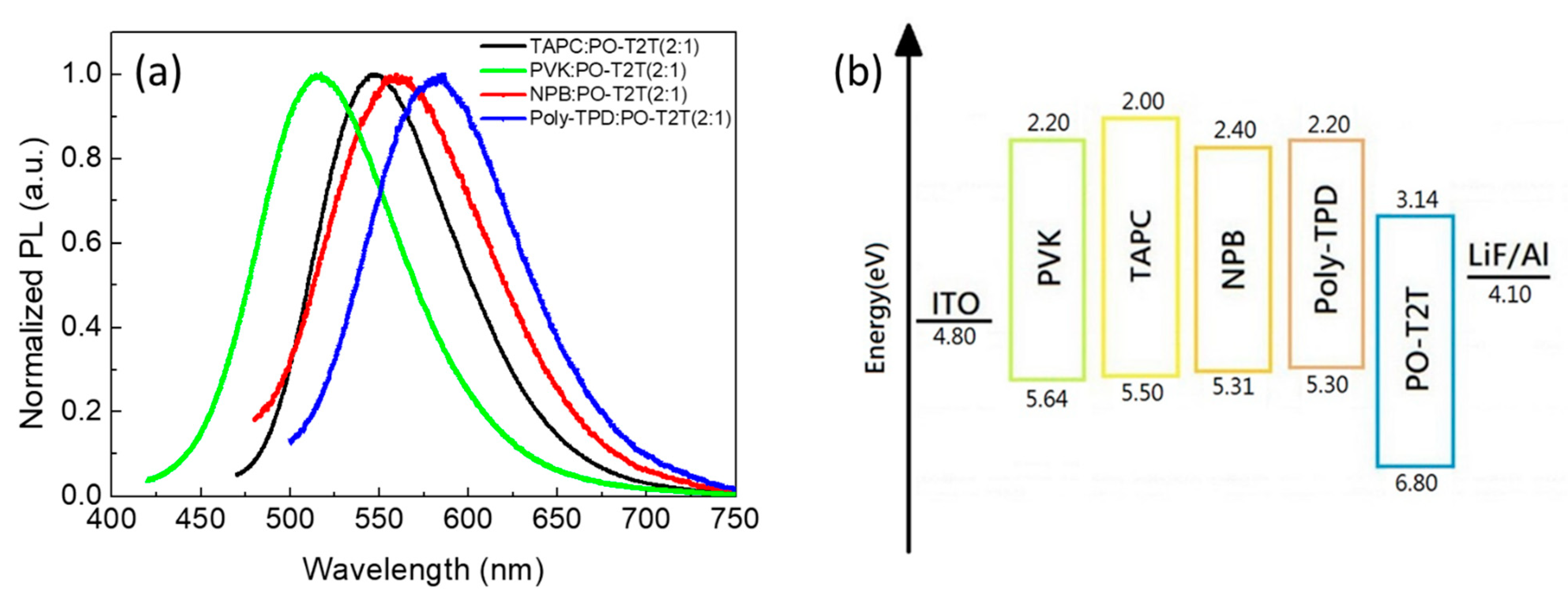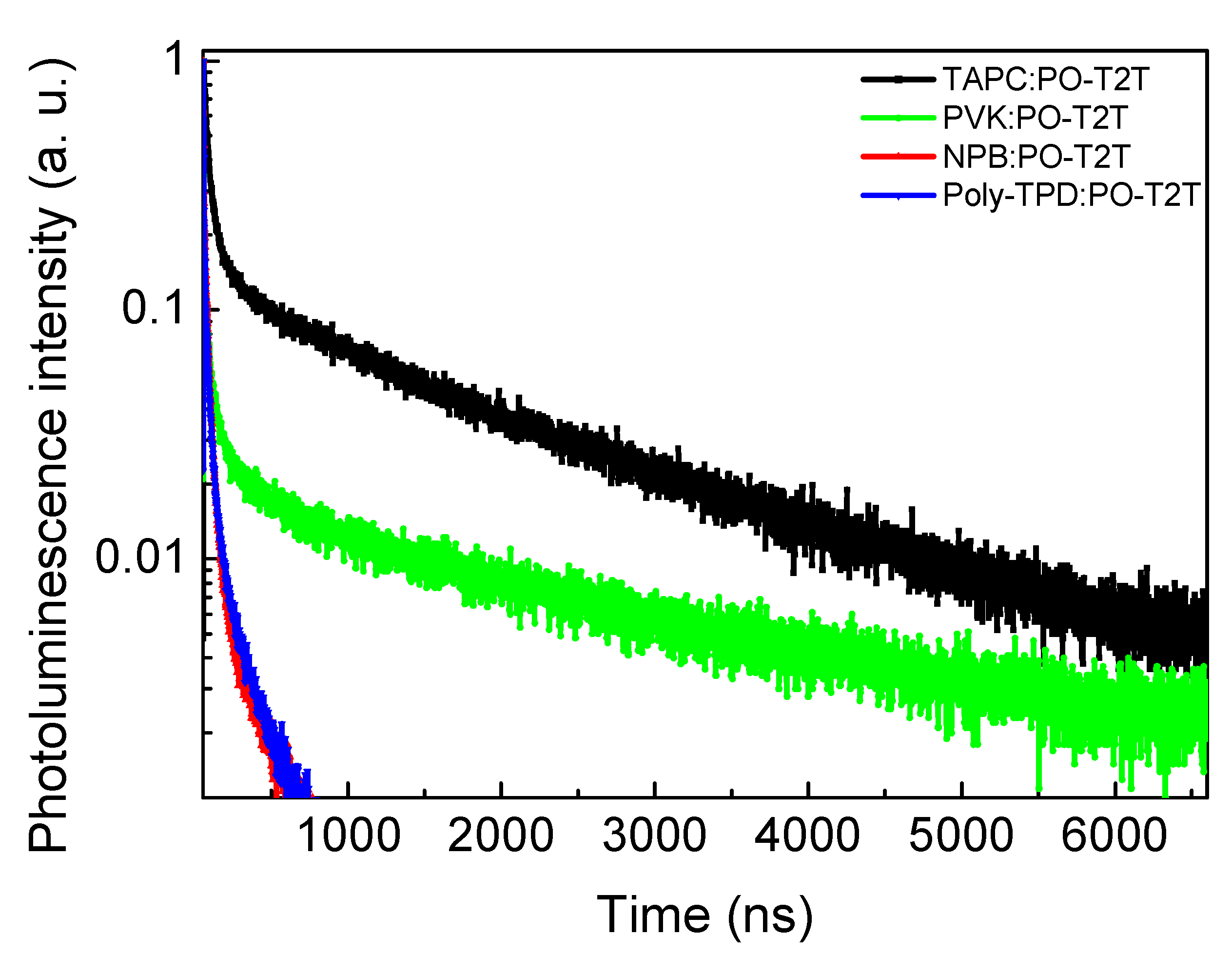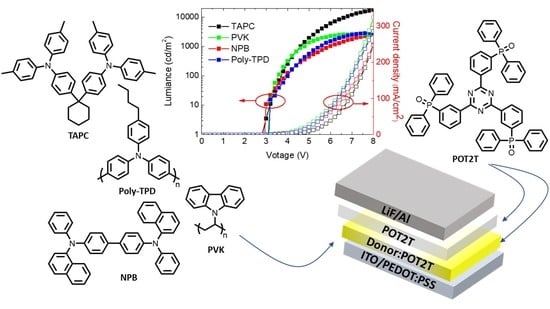Thermally Activated Delayed Fluorescence in Commercially Available Materials for Solution-Process Exciplex OLEDs
Abstract
1. Introduction
2. Experimental Section
3. Results and Discussion
4. Conclusions
Supplementary Materials
Author Contributions
Funding
Institutional Review Board Statement
Informed Consent Statement
Data Availability Statement
Acknowledgments
Conflicts of Interest
References
- Uoyama, H.; Goushi, K.; Shizu, K.; Nomura, H.; Adachi, C. Highly efficient organic light-emitting diodes from delayed fluorescence. Nature 2012, 492, 234–238. [Google Scholar] [CrossRef] [PubMed]
- Nobuyasu, R.S.; Ren, Z.; Griffiths, G.C.; Batsanov, A.S.; Data, P.; Yan, S.; Monkman, A.P.; Bryce, M.R.; Dias, F.B. Rational design of TADF polymers using a donor–acceptor monomer with enhanced TADF efficiency induced by the energy alignment of charge transfer and local triplet excited states. Adv. Opt. Mater. 2016, 4, 597–607. [Google Scholar] [CrossRef]
- Zhang, Q.; Tsang, D.; Kuwabara, H.; Hatae, Y.; Li, B.; Takahashi, T.; Lee, S.Y.; Yasuda, T.; Adachi, C. Nearly 100% internal quantum efficiency in undoped electroluminescent devices employing pure organic emitters. Adv. Mater. 2015, 27, 2096–2100. [Google Scholar] [CrossRef] [PubMed]
- Kaji, H.; Suzuki, H.; Fukushima, T.; Shizu, K.; Suzuki, K.; Kubo, S.; Komino, T.; Oiwa, H.; Suzuki, F.; Wakamiya, A. Purely organic electroluminescent material realizing 100% conversion from electricity to light. Nat. Commun. 2015, 6, 8476. [Google Scholar] [CrossRef]
- Lin, T.A.; Chatterjee, T.; Tsai, W.L.; Lee, W.K.; Wu, M.J.; Jiao, M.; Pan, K.C.; Yi, C.L.; Chung, C.L.; Wong, K.T. Sky-blue organic light emitting diode with 37% external quantum efficiency using thermally activated delayed fluorescence from spiroacridine-triazine hybrid. Adv. Mater. 2016, 28, 6976–6983. [Google Scholar] [CrossRef]
- Rajamalli, P.; Senthilkumar, N.; Huang, P.-Y.; Ren-Wu, C.-C.; Lin, H.-W.; Cheng, C.-H. New molecular design concurrently providing superior pure blue, thermally activated delayed fluorescence and optical out-coupling efficiencies. J. Am. Chem. Soc. 2017, 139, 10948–10951. [Google Scholar] [CrossRef]
- Maeng, J.H.; Ahn, D.H.; Lee, H.; Jung, Y.H.; Karthik, D.; Lee, J.Y.; Kwon, J.H. Rigid indolocarbazole donor moiety for highly efficient thermally activated delayed fluorescent device. Dye. Pigment. 2020, 180, 108485. [Google Scholar] [CrossRef]
- Xie, F.-M.; Zhou, J.-X.; Li, Y.-Q.; Tang, J.-X. Effects of the relative position and number of donors and acceptors on the properties of TADF materials. J. Mater. Chem. C 2020, 8, 9476–9494. [Google Scholar] [CrossRef]
- Jiang, T.; Liu, Y.; Ren, Z.; Yan, S. The design, synthesis and performance of thermally activated delayed fluorescence macromolecules. Polym. Chem. 2020, 11, 1555–1571. [Google Scholar] [CrossRef]
- Barman, D.; Gogoi, R.; Narang, K.; Iyer, P.K. Recent Developments on Multi-Functional Metal-Free Mechanochromic Luminescence and Thermally Activated Delayed Fluorescence Organic Materials. Front. Chem. 2020, 8, 483. [Google Scholar] [CrossRef]
- Goushi, K.; Yoshida, K.; Sato, K.; Adachi, C. Organic light-emitting diodes employing efficient reverse intersystem crossing for triplet-to-singlet state conversion. Nat. Photonics 2012, 6, 253–258. [Google Scholar] [CrossRef]
- Zhang, T.; Chu, B.; Li, W.; Su, Z.; Peng, Q.M.; Zhao, B.; Luo, Y.; Jin, F.; Yan, X.; Gao, Y. Efficient triplet application in exciplex delayed-fluorescence oleds using a reverse intersystem crossing mechanism based on a δ es–t of around zero. ACS Appl. Mater. Interfaces 2014, 6, 11907–11914. [Google Scholar] [CrossRef] [PubMed]
- Hung, W.-Y.; Fang, G.-C.; Chang, Y.-C.; Kuo, T.-Y.; Chou, P.-T.; Lin, S.-W.; Wong, K.-T. Highly efficient bilayer interface exciplex for yellow organic light-emitting diode. ACS Appl. Mater. Interfaces 2013, 5, 6826–6831. [Google Scholar] [CrossRef] [PubMed]
- Data, P.; Pander, P.; Okazaki, M.; Takeda, Y.; Minakata, S.; Monkman, A.P. Dibenzo [a, j] phenazine-Cored Donor–Acceptor–Donor Compounds as Green-to-Red/NIR Thermally Activated Delayed Fluorescence Organic Light Emitters. Angew. Chem. Int. Ed. 2016, 55, 5739–5744. [Google Scholar] [CrossRef]
- dos Santos, P.L.; Dias, F.B.; Monkman, A.P. Investigation of the mechanisms giving rise to TADF in exciplex states. J. Phys. Chem. C 2016, 120, 18259–18267. [Google Scholar] [CrossRef]
- Hung, W.-Y.; Fang, G.-C.; Lin, S.-W.; Cheng, S.-H.; Wong, K.-T.; Kuo, T.-Y.; Chou, P.-T. The first tandem, all-exciplex-based WOLED. Sci. Rep. 2014, 4, 5161. [Google Scholar] [CrossRef] [PubMed]
- Cherpak, V.; Stakhira, P.; Minaev, B.; Baryshnikov, G.; Stromylo, E.; Helzhynskyy, I.; Chapran, M.; Volyniuk, D.; Hotra, Z.; Dabuliene, A. Mixing of phosphorescent and exciplex emission in efficient organic electroluminescent devices. ACS Appl. Mater. Interfaces 2015, 7, 1219–1225. [Google Scholar] [CrossRef]
- Cherpak, V.; Gassmann, A.; Stakhira, P.; Volyniuk, D.; Grazulevicius, J.V.; Michaleviciute, A.; Tomkeviciene, A.; Barylo, G.; von Seggern, H. Three-terminal light-emitting device with adjustable emission color. Org. Electron. 2014, 15, 1396–1400. [Google Scholar] [CrossRef]
- Volyniuk, D.; Cherpak, V.; Stakhira, P.; Minaev, B.; Baryshnikov, G.; Chapran, M.; Tomkeviciene, A.; Keruckas, J.; Grazulevicius, J.V. Highly efficient blue organic light-emitting diodes based on intermolecular triplet–singlet energy transfer. J. Phys. Chem. C 2013, 117, 22538–22544. [Google Scholar] [CrossRef]
- Pander, P.; Gogoc, S.; Colella, M.; Data, P.; Dias, F.B. Thermally Activated Delayed Fluorescence in Polymer–Small-Molecule Exciplex Blends for Solution-Processed Organic Light-Emitting Diodes. ACS Appl. Mater. Interfaces 2018, 10, 28796–28802. [Google Scholar] [CrossRef]
- Zhao, J.; Zheng, C.; Zhou, Y.; Li, C.; Ye, J.; Du, X.; Li, W.; He, Z.; Zhang, M.; Lin, H. Novel small-molecule electron donor for solution-processed ternary exciplex with 24% external quantum efficiency in organic light-emitting diode. Mater. Horiz. 2019, 6, 1425–1432. [Google Scholar] [CrossRef]
- Zhao, J.; Huang, Y.; Guo, J.; Zhang, N.; Zheng, C.; Du, X.; Lin, H.; Tao, S. Study of All Solution Processed Exciplex Organic Light-Emitting Diode. In Proceedings of the IOP Conference Series: Materials Science and Engineering; IOP Publishing: Bristol, UK, 2021; p. 022014. [Google Scholar]
- Zhong, P.-L.; Zheng, C.-J.; Zhang, M.; Zhao, J.-W.; Yang, H.-Y.; He, Z.-Y.; Lin, H.; Tao, S.-L.; Zhang, X.-H. Highly efficient ternary polymer-based solution-processable exciplex with over 20% external quantum efficiency in organic light-emitting diode. Org. Electron. 2020, 76, 105449. [Google Scholar] [CrossRef]
- Zhao, B.; Zhang, H.; Miao, Y.; Wang, Z.; Gao, L.; Wang, H.; Hao, Y.; Li, W. High color stability and CRI (> 80) fluorescent white organic light-emitting diode based pure emission of exciplexes by employing merely complementary colors. J. Mater. Chem. C 2018, 6, 304–311. [Google Scholar] [CrossRef]
- Wei, X.; Gao, L.; Miao, Y.; Zhao, Y.; Yin, M.; Wang, H.; Xu, B. A new strategy for structuring white organic light-emitting diodes by combining complementary emissions in the same interface. J. Mater. Chem. C 2020, 8, 2772–2779. [Google Scholar] [CrossRef]
- Gordon, M. The Exciplex; Elsevier: Amsterdam, The Netherlands, 2012. [Google Scholar]
- Pander, P.; Kudelko, A.; Brzeczek, A.; Wroblowska, M.; Walczak, K. Analysis of exciplex emitters. Disp. Imaging 2017, 2, 265–277. [Google Scholar]
- Świst, A.; Cabaj, J.; Sołoducho, J.; Data, P.; Łapkowski, M. Novel acridone-based branched blocks as highly fluorescent materials. Synth. Met. 2013, 180, 1–8. [Google Scholar] [CrossRef]
- Vamvounis, G.; Aziz, H.; Hu, N.-X.; Popovic, Z.D. Temperature dependence of operational stability of organic light emitting diodes based on mixed emitter layers. Synth. Met. 2004, 143, 69–73. [Google Scholar] [CrossRef]
- Kondakov, D. Characterization of triplet-triplet annihilation in organic light-emitting diodes based on anthracene derivatives. J. Appl. Phys. 2007, 102, 114504. [Google Scholar] [CrossRef]






| Year | Von (V) | EML | CE (cd/A) | PE (lm/W) | EQE (%) | Method | Reference |
|---|---|---|---|---|---|---|---|
| 2018 | 4.9 | PVK:PO-T2T | 13.3 | - | 4.5 | Solution process | [20] |
| 2018 | 3 | TAPC:PO-T2T | 11.8 | 11.8 | 5.1 | Vacuum deposition | [24] |
| 2019 | 2.4 | TPA-3:PO-T2T | 44.8 | 41.5 | 14.4 | Solution process | [21] |
| 2019 | 2.3 | DTF:PO-T2T | 19.7 | 24.7 | 6 | Solution process | [21] |
| 2020 | 3.5 | PVK:PO-T2T | 15 | 7 | 4.75 | Solution process | [22] |
| 2020 | 3.5 | mCP:PO-T2T | 6.7 | 5.4 | 3 | Solution process | [23] |
| 2020 | 3 | PVK:PO-T2T | 14.8 | 9.3 | 4.6 | Solution process | [23] |
| 2020 | 3 | TAPC:PO-T2T | 4.49 | 4.21 | 1.67 | Vacuum deposition | [25] |
| 2021 | 2.8 | TAPC:PO-T2T | 17.2 | 16.9 | 7.1 | Solution process | This work |
| Exciplex | IPD − EAA, eV a | CT, eV b | LT, eV c | ΔEST, eV d |
|---|---|---|---|---|
| TAPC:POT2T | 2.36 | 2.272 | 2.248 | 0.024 |
| PVK:POT2T | 2.50 | 2.399 | 2.382 | 0.017 |
| NPB:POT2T | 2.17 | 2.215 | 2.112 | 0.103 |
| Poly-TPD:POT2T | 2.16 | 2.116 | 2.087 | 0.029 |
| Device | EL (nm) | Turn-On Voltage, at 1 cd/m2 | Maximum EQE/EQE at 10 mA/cm2 (%) | Maximum Power Efficiency/Power Efficiency at 10 mA/cm2 (lm/W) |
|---|---|---|---|---|
| Dev1 | 556 | 2.81 | 7.10/6.53 | 16.9/12.94 |
| Dev2 | 535 | 2.82 | 1.92/1.91 | 4.43/4.16 |
| Dev3 | 593 | 3.01 | 1.10/1.09 | 2.08/1.50 |
| Dev4 | 598 | 3.01 | 1.53/1.49 | 3.56/2.01 |
| Device | Thickness (nm) | Turn-On Voltage, at 1 cd/m2 | Maximum EQE/EQE at 10 mA/cm2 (%) | Maximum Power Efficiency/Power Efficiency at 10 mA/cm2 (lm/W) |
|---|---|---|---|---|
| Dev5 | 43 ± 2 | 3.41 | 6.48/5.68 | 13.51/8.92 |
| Dev6 | 36 ± 2 | 2.81 | 7.10/6.53 | 16.90/12.94 |
| Dev7 | 27 ± 3 | 2.62 | 5.75/5.22 | 16.06/11.49 |
| Dev8 | 14 ± 2 | 2.22 | 4.61/4.37 | 15.10/12.52 |
Publisher’s Note: MDPI stays neutral with regard to jurisdictional claims in published maps and institutional affiliations. |
© 2021 by the authors. Licensee MDPI, Basel, Switzerland. This article is an open access article distributed under the terms and conditions of the Creative Commons Attribution (CC BY) license (https://creativecommons.org/licenses/by/4.0/).
Share and Cite
Tseng, Z.-L.; Huang, W.-L.; Yeh, T.-H.; Xu, Y.-X.; Chiang, C.-H. Thermally Activated Delayed Fluorescence in Commercially Available Materials for Solution-Process Exciplex OLEDs. Polymers 2021, 13, 1668. https://doi.org/10.3390/polym13101668
Tseng Z-L, Huang W-L, Yeh T-H, Xu Y-X, Chiang C-H. Thermally Activated Delayed Fluorescence in Commercially Available Materials for Solution-Process Exciplex OLEDs. Polymers. 2021; 13(10):1668. https://doi.org/10.3390/polym13101668
Chicago/Turabian StyleTseng, Zong-Liang, Wei-Lun Huang, Tzu-Hung Yeh, You-Xun Xu, and Chih-Hsun Chiang. 2021. "Thermally Activated Delayed Fluorescence in Commercially Available Materials for Solution-Process Exciplex OLEDs" Polymers 13, no. 10: 1668. https://doi.org/10.3390/polym13101668
APA StyleTseng, Z.-L., Huang, W.-L., Yeh, T.-H., Xu, Y.-X., & Chiang, C.-H. (2021). Thermally Activated Delayed Fluorescence in Commercially Available Materials for Solution-Process Exciplex OLEDs. Polymers, 13(10), 1668. https://doi.org/10.3390/polym13101668







